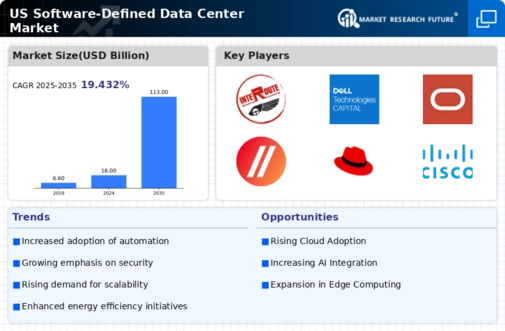Shift Towards Automation
Automation is becoming a cornerstone of the software defined-data-center market, as organizations strive to enhance efficiency and reduce human error. The push for automation is largely influenced by the need for faster deployment of services and improved management of IT resources. Data suggests that automated processes can decrease operational costs by approximately 25%, making them an attractive option for businesses. Furthermore, automation facilitates better resource utilization, allowing organizations to allocate their IT budgets more effectively. As the software defined-data-center market evolves, the emphasis on automation is expected to grow, with companies investing in tools and technologies that support automated workflows and processes.
Emergence of Edge Computing
The emergence of edge computing is reshaping the software defined-data-center market, as organizations seek to process data closer to the source. This shift is driven by the increasing volume of data generated by IoT devices and the need for real-time analytics. Edge computing enables faster data processing and reduces latency, which is crucial for applications requiring immediate responses. Recent estimates suggest that the edge computing market could reach $15 billion by 2027, indicating a substantial opportunity for growth within the software defined-data-center market. As businesses adopt edge solutions, they are likely to enhance their operational capabilities, making this trend a significant driver of innovation and investment.
Rising Demand for Scalability
The software defined-data-center market is experiencing a notable surge in demand for scalability solutions. Organizations are increasingly seeking flexible infrastructure that can adapt to fluctuating workloads. This trend is driven by the need for businesses to respond swiftly to market changes and customer demands. According to recent data, approximately 70% of enterprises in the US are prioritizing scalable solutions to enhance operational efficiency. The ability to scale resources up or down without significant capital expenditure is becoming a critical factor in decision-making. As a result, vendors in the software defined-data-center market are innovating to provide solutions that allow for seamless scalability, thereby positioning themselves competitively in a rapidly evolving landscape.
Integration of Artificial Intelligence
The integration of artificial intelligence (AI) into the software defined-data-center market is transforming operational capabilities. AI technologies are being utilized to optimize resource allocation, enhance predictive maintenance, and improve overall system performance. This integration appears to be a key driver, as organizations recognize the potential of AI to streamline operations and reduce costs. Recent studies indicate that AI-driven solutions can lead to a reduction in operational costs by up to 30%. As AI continues to evolve, its application within the software defined-data-center market is likely to expand, fostering innovation and efficiency. Companies that leverage AI effectively may gain a competitive edge, making this integration a pivotal focus for future developments.
Growing Focus on Compliance and Governance
In the software defined-data-center market, compliance and governance are increasingly becoming focal points for organizations. As regulatory requirements evolve, businesses are compelled to adopt solutions that ensure data security and compliance with industry standards. This trend is particularly pronounced in sectors such as finance and healthcare, where data protection is paramount. Approximately 60% of organizations in the US report that compliance concerns significantly influence their IT infrastructure decisions. Consequently, vendors in the software defined-data-center market are developing solutions that not only meet compliance requirements but also enhance governance frameworks, thereby addressing the needs of their clients in a complex regulatory landscape.

















Leave a Comment